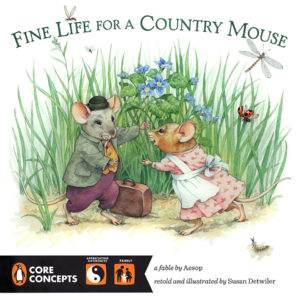
Susan Detwiler grew up in Maryland and lives in Baltimore with her husband and two sons. In addition to her work as a children’s book illustrator, Detwiler has created illustrations for advertising, merchandise and greeting cards. Her work has been commissioned by many local businesses and institutions, including Baltimore Precision Instruments, Johns Hopkins Women’s Health and McDonogh School, as well as national organizations such as Girl Scouts USA, Hallmark Cards and The Nature Conservancy. Learn more about Susan and her work in children’s literature.
When I’m working on a picture book, I gather reference material and produce a pencil sketch, sometimes with color added. Some assignments require character sketches, and, in the case of a book, a dummy. I make thumbnail sketches first so that the composition of the page can be depicted quickly and changed easily. Those thumbnails are all on one sheet of paper so that the book can be seen as a whole.
The sketching process is the real work for me, and it may take many tries to get to the point where I am satisfied enough to show it for approval. Once the sketch is approved, I proceed to completion of the final art. If the illustration will be done in watercolor, I transfer the image to watercolor paper or illustration board and I apply the color. Often I enhance and touch up the images digitally after the watercolor final is scanned by using Photoshop. I consider the pacing of the story and, although showing the most important scenes is usually the way to go, the best illustrations add to the text rather than depicting exactly what is written.
The preliminary work of choosing scenes and establishing the pace of the narrative can be difficult and time consuming, but it is crucial. My work tends to be very detailed because that’s what I liked as a child; the details help create a believable world.
I love to draw and paint animals, and depicting trees and other plants is also a pleasure. Humans, especially children, are fun to draw too. I can relate to children and remember what it felt like to be a child. Emotional honesty is essential in books for children. As an artist, I see beauty all around me, all the time. I try to create images that help others to see that beauty as well.
I spend a lot of time at the beginning of a book assignment doing research at the library and online. I like to have many photographs in front of me when I work so that I can fully understand the structure, texture and light and shadows of what I am trying to depict. It also helps to know other details about the subject.
Along with gathering pictures, I read about what I am illustrating. I also draw from life. There is a little bit of my German Shepherd, Molly, in every wolf I painted for “One Wolf Howls” by Scotti Cohn (Arbordale Publishing, 2009). She was a very helpful model! My “Country Mouse” has a pet ladybug which I’ve included in the illustrations but not in the text. Also, the boy holding a teddy bear on the title page of “The First Teddy Bear” (Stemmer House, 2005) looks remarkably like my younger son, although I had no children at the time I painted it.

So far, I am both author and illustrator for only one book, “Fine Life for a Country Mouse” (Grosset & Dunlap, 2014). It remains dear to my heart and my favorite title. The manuscript went through several changes over the decade that I sought a publisher.
Sometimes I get a very clear set of images in my mind immediately upon reading a manuscript, as was the case for the book “One Wolf Howls.” However, sometimes a manuscript poses greater challenges. When I created the illustrations for “The Sparrow and the Trees” by Sharon Chriscoe (Arbordale Publishing, 2015), several aspects of the story required careful thought. I had to figure out a way to depict the very large tree characters talking to the tiny protagonist. It was also important to let the Native American origin of the story shine through, even though there are no human characters in the story.
Susan’s advice to aspiring children’s book illustrators: “Make art often and practice different styles by mimicking your favorite artists’ work. Keep a sketchbook. Eventually you will have a style that is all your own. If you are a student, use your ability to make images wherever possible in school, such as illustrating reports or making posters for school events.”
facebook.com/SusanDetwilerCustomArtwork
susandetwiler.com | Also look for Susan’s work on childrensillustrators.com








